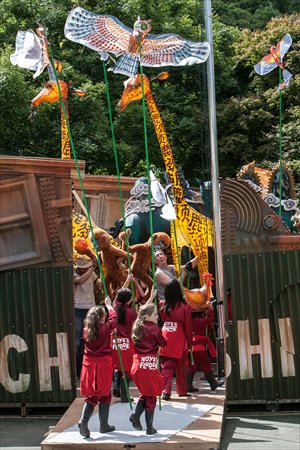'Noye's Fludde' sails into Beijing

When most people think about a place that gathers pandas, cranes, zebras, giraffes, lions and tigers in one place, a zoo comes to mind. But in the apocalyptic year 2012, there is a better answer: Noah's ark.
And that ark is on the way to Beijing now, in the form of the children's opera Noye's Fludde, composed by Benjamin Britten.
This production debuted in the Belfast Zoo during the 2012 Olympic Games. Co-produced by the KT Wong Foundation and Northern Ireland Opera, Noye's Fludde is bringing a bit of Belfast to China on October 27 at The Orange, Sanlitun Village.
Fun for children
Noah's story is familiar to all Westerners. But the opera adds a modern twist, focusing on global warming and climate change as well as the relationship between humans and nature. The young performers have been practicing intensively for their debut in Beijing next week, as part of the Beijing Music Festival.
"We wanted to introduce Britten's music to Chinese audiences, and what better way than through a children's opera? Benjamin Britten wrote Noye's Fludde as an opera for the community and we wanted to include the children from the Beijing community. This is what the foundation is trying to do in China. Classical music and opera are not just for the elites, it is for everybody," Lady Linda Wong Davies, chairman of the KT Wong Foundation, wrote in an email to Global Times.
Britten was a prolific English composer whose work includes A Midsummer Night's Dream (1960) and Death in Venice (1973). Noye's Fludde was written in 1958. Because it is a story from the Bible, Britten used church music as his inspiration. To be true to Britten's idea, the production team brought 12 church bells from England to China.
"Britten explores typical structures of hymns and the audience is asked to participate, as you would in a church," Davies said.
A highlight of the opera is its special visual effects, props and costumes. Designed by both British and Chinese, the props include kites and colorful lanterns, and are made in a traditional Chinese style. Some of the animals are almost the same size as real ones.
Davies brought the show's designer Simon Holdsworth to the Natural History Museum in London to study a portfolio collection of 19th century zoological paintings done by Chinese artists. She hoped to introduce Chinese folklore, Chinese costumes and Chinese mythology to Westerners through the design of the animals.
She found these 19th century Chinese artists painted in the European style because it was for the European market, but still retained a very distinctive Chinese style. "Simon also did his own research and through this combination we have created our own unique vision for the animals…We didn't choose animals randomly. Britten was very clear about what animals he wanted and wrote specific music for them," Davies said.
Western and Eastern lenses
The KT Wong Foundation focuses on creating cultural projects that partner China with other countries. It brought the opera Semele, directed by Chinese contemporary artist Zhang Huan, to China two years ago. Zhang interpreted the Greek myth through the lens of Chinese philosophy, and used traditional Chinese-style architecture as his main setting. In Noye's Fludde, the combination of Western and Chinese elements remains, but the angle is different. Although both shows insert Chinese culture and imagery into a Western plot, one is through Chinese eyes to view Western culture while the other is through Western eyes to see Chinese culture.
Davies explained that Britten himself was influenced by Japanese and Chinese culture when he came to visit the Far East.
"There is an interesting use of percussion in the Noye's Fludde orchestration. There are the sounds of Chinese blocks and we have to find instruments to imitate that," Davies said.
This kind of fusion is a popular trend in China at the moment. Sun Yuanyuan, an associate professor at Beijing's Central Conservatory of Music, said that in the era of globalization, this kind of combination can help both sides understand each other's cultural context and reduce the cultural gap.
Wen Shuo, a Chinese music critic, says this trend reflects local and international integration. But it doesn't always work. He said the approach requires careful consideration of the music, dance and the theme of a show to achieve a natural and artistic result. "If the mixture is too stiff, it can't be a successful show," said Wen.
Market for opera
Although Davies treats the opera as a show for everyone, the market in China is not the same in the UK.
Davies's original plan was to hold the performance in the Beijing Zoo. However, she was rejected. Officials found it hard to understand why an opera should be performed in a zoo. Davies believes this decision is a loss.
"In Belfast, our director Oliver Mears used the physical environment of the zoo to his advantage… A lake behind the boat and hills were used as an impressive backdrop. The audience watched the show seated on grass and with the animals entering and exiting from the woods. Oliver's use of the surroundings created wonderful scenes with great dramatic value," he said.
Sun said although top musicians and artists around the world have more opportunities to come to China nowadays, the market for opera is not growing. She explained that opera as a traditional art form exists within a deep historical and cultural context. It requires a certain knowledge to understand and appreciate it.
"It is same case in many other countries, but the way their markets operate is more mature," said Sun, who thinks children's opera is a good way to develop the potential market and introduce opera to kids.
Davies is optimistic and is looking forward to performing outdoors in other cities in China next time. "It is slowly changing. People are becoming more open to doing shows in special venues other than ordinary concert halls."